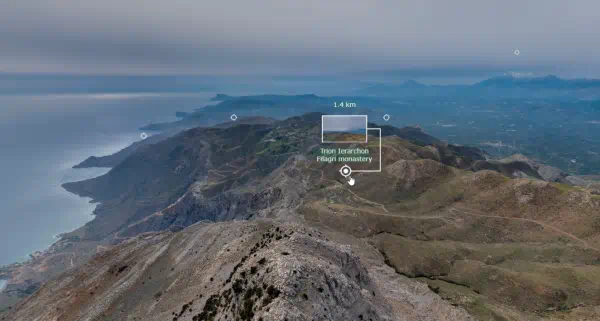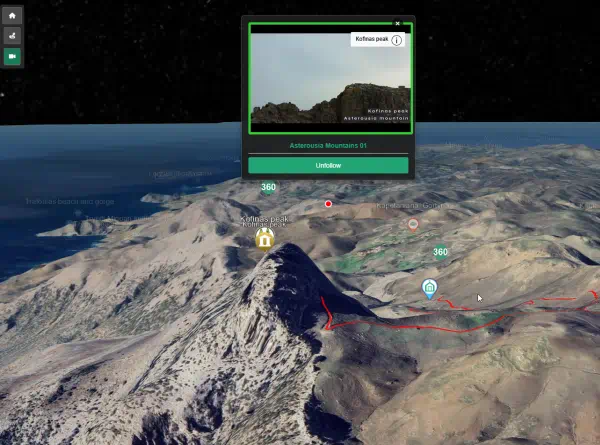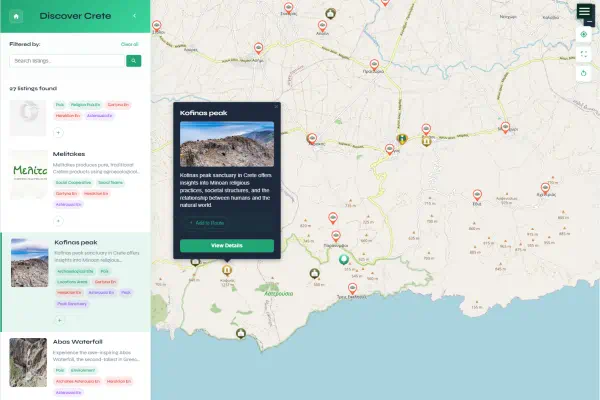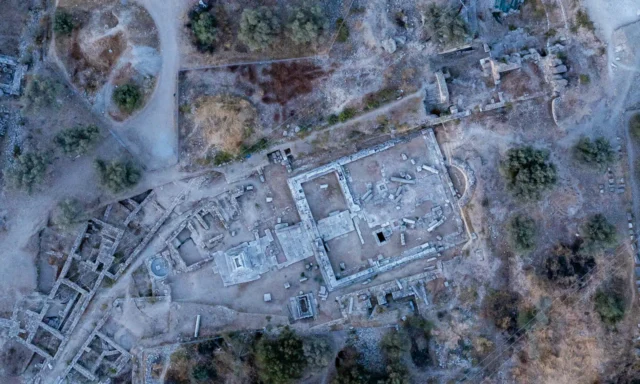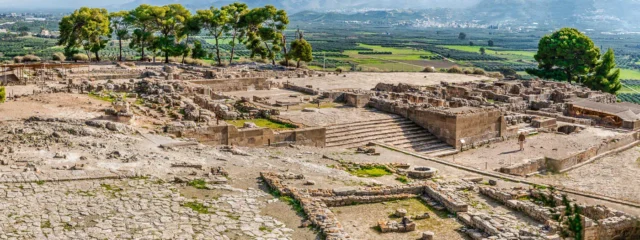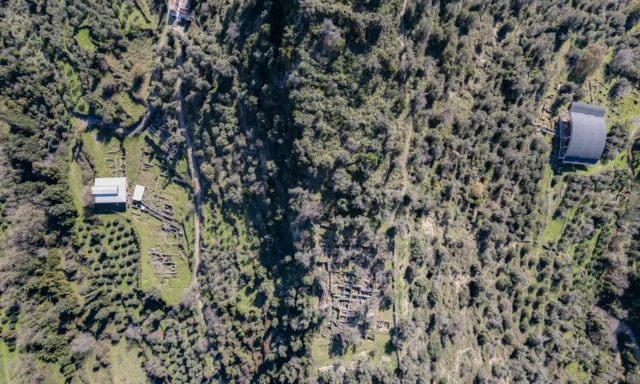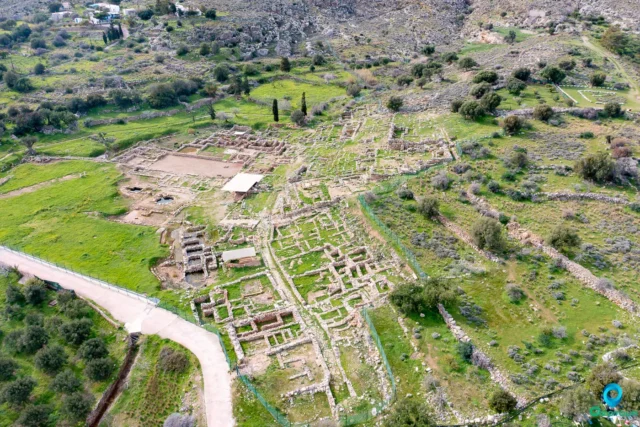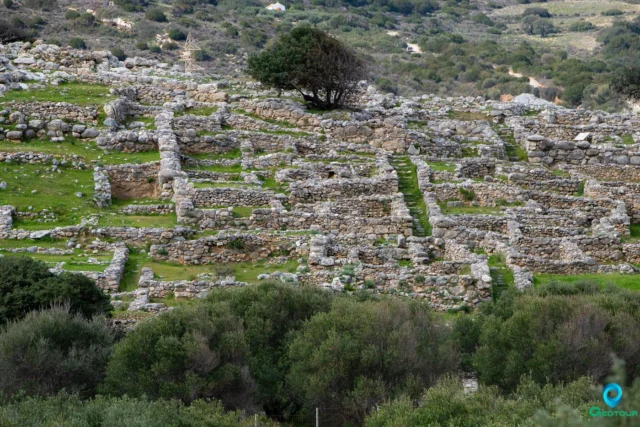Kavousi (also: Kavousion) is a village and the seat of the homonymous community of the Municipality of Ierapetra, in the Regional Unit of Lasithi in eastern Crete. According to the 2011 census it has 559 inhabitants.
It is built at an altitude of 140 meters, at the foot of the Afendis height of Mount Thrypti and is located on the road Agios Nikolaos – Sitia. It is 17 kilometers from Ierapetra, 24 kilometers from Agios Nikolaos and 40 kilometers from Sitia. The main product produced in the area is olive oil, while there is also production of essential oils from the aromatic plants of the area. Its name in the Cretan dialect means a pit where water gathers.
History
The village is surrounded by many sites of archaeological interest, such as Vrontas, the side of Kastro (both are pre-Minoan settlements) and Azorias, a hill on which a city of archaic times has been discovered. Also, in the surrounding area, Byzantine churches have been found, such as that of the Holy Apostles, with frescoes from 1456. The oldest mention of the village is made in 1577 by Francesco Barozzi. Kavousi was a large village during the Venetian rule. In the Castrofylakas census of 1583 it is mentioned as Cavussi with 637 inhabitants. In the Egyptian census of 1834 it had 100 families of Christians and Turks. In 1881 it had 636 Christian inhabitants and 310 Turks.[1]
Infrastructure
In Kavousi there is a community office, a rural medical clinic, a cultural association, an agricultural cooperative and a music high school (in the premises of the former elementary school and kindergarten). There are also grocery stores, a bakery, pastry shops, cafes and taverns in the village, as well as guesthouses. The Kavousi bus stop is served by lines to/from Sitia, Agios Nikolaos – Heraklion and Ierapetra. There are also KTEO facilities in the community area.
Religious Sites
Holy Trinity Parish of Kavousi
Kavousi is also the seat of a parish of the Holy Metropolis of Ierapytnis and Siteia. Today’s parish church of Kavousi is the Church of Agia Triada located on the main road. It was founded in 1957 and inaugurated on September 2, 1962. Until then, the two-aisled church of the Dormition of the Mother of God and Agios Ioannis Theologos, located in a beautiful place behind the village square, was the parish church of Kavousi. In the southern part of the village are the frescoed churches of the Holy Apostles and Agios Georgios (15th century). Within the village there are also the churches of the Transfiguration of the Savior, Michael the Archangel and Prophet Elijah.
South of the village, above the road to Pahia Ammos, dominates the cemetery with the frescoed chapel of Zoodochos Pigi (14th century). Below it, on the road, is the newer church of Agioi Anargyroi and Agia Anastasia. A short distance from it, in the position of Liofyta, is the church of Agios Ioannis Prodromos among olive trees. Further towards Pahia Ammos, there is also the newer chapel of Agios Fanourios.
Near the small beach of Agriomandra, west of Kavousi, is the ruined cave church of Agios Ioannis.
On the beach of Tholos, in the northern part of the community, there is the church of the Ascension at the western end of the beach and the newer chapel of Ag. Raphael, Nikolaos and Irene, on the opposite eastern side of the beach of Tholos. About 1.2 kilometers south of the Ascension is the frescoed church of Agios Antonios (14th century).
On the road to Siteia, in Platanos, is the church of Agios Nektarios and Agion Panton, which was built in just one night from June 4 to 5, 1963 in a panoramic position overlooking the Gulf of Mirabello.
East of the village, on the road to the valley of Augou and Thrypti and a little after the monumental olive tree of Azorias is the church of Panagia Protoseptemvriani, while on the path to Thrypti are the ruined church of Agios Konstantinos and Eleni as well as the church of Agia Paraskevi in Xerambela, very little frescoed.
In the valley of Augou there are the churches of Agio Pnevma, Gennisi Theotokou (in the settlement of Panagia), Agios Ioannis Prodromos and the frescoed Agia Irene (1411) (in Melisses). The most remote church of the parish from Kavousi is that of Agios Nikitas, above Tsamantis.
In total, the Holy Trinity Parish of Kavousi has 24 churches.
Settlement: Key Points
- Historical References: First mentioned in 1577 by Francesco Barozzi; large village during Venetian rule.
- Location: Situated at the foot of Mount Thrypti in eastern Crete, along the Agios Nikolaos – Sitia road.
- Historical Significance: Surrounded by sites of archaeological interest, including pre-Minoan and Archaic settlements.
- Population Data:
YearPopulationNotes1583637Cavussi1881955636 Christians, 319 Muslim1900745192089919288691940999195110131961961197182319817151991684200160420115592021537
- Current Status: A vibrant village in the municipality of Ierapetra, known for its olive oil production and historical landmarks.
References

